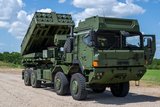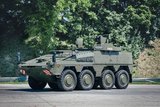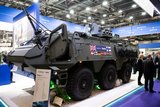DARPA eyes critical design maturity for OpFires
Lockheed Martin is helping DARPA to develop a new ground-launched intermediate-range hypersonic weapon. (Image: DARPA)
Lockheed Martin Missiles and Fire Control has received another contract modification from DARPA for work on the Operational Fires (OpFires) Integrated Weapon System programme.
The company will conduct risk-reduction testing by September 2022 to achieve ‘system-level critical design maturity’, the DoD announced on 4 March.
DARPA awarded the original $31.9 million contract to Lockheed Martin in January 2020. The latest modification is worth $9.21 million.
OpFires Integrated Weapon System Phase 3 is intended to enable a mobile, ground-launched tactical weapon delivery system capable of carrying various payloads.
The overall goal of the OpFires programme is to develop and demonstrate a novel ground-launched system enabling hypersonic boost glide weapons to penetrate modern enemy air defences and ‘rapidly and precisely engage critical time-sensitive targets’, according to DARPA.
OpFires seeks to develop an advanced booster capable of delivering a variety of payloads at a variety of ranges. Additional considerations include the need for compatible mobile ground launch platforms to integrate existing ground forces and infrastructure, and specific system attributes required for rapid deployment and redeployment.
More from Land Warfare
-
![Croatia orders Leopards and CAESAR howitzers as Lithuania orders more CAESARs]()
Croatia orders Leopards and CAESAR howitzers as Lithuania orders more CAESARs
The Leopard is becoming the tank of choice in central and eastern Europe as Croatia joins Lithuania, the Czech Republic and Hungary in ordering the platform. Lithuania and Croatia have also signed for CAESAR howitzers.
-
![Light Reconnaissance Strike – enabling a vital mission set (Studio)]()
Light Reconnaissance Strike – enabling a vital mission set (Studio)
A new system-of-systems concept will unlock digital integration of sensors and weapons for Light Forces, allowing them to shape the battlefield environment on their own terms and upgrade legacy platforms.
-
![Lockheed Martin to look further afield for GMARS rocket system opportunities]()
Lockheed Martin to look further afield for GMARS rocket system opportunities
The HX truck is already in use in many NATO and allied countries around the world as a logistics vehicle and carrier for high-value systems, including missile firing weapons, so its use for the Global Mobile Artillery Rocket System makes logistical sense.
-
![Lithuanian 1st Division to achieve initial operating capability in 2026]()
Lithuanian 1st Division to achieve initial operating capability in 2026
Lithuania is one of the countries stepping up its defences in the face of the war in Ukraine with a particular focus on its neighbour and Russian ally Belarus, which has been making incursions into Lithuania’s airspace with balloons and drones.
-
![Beyond Survivability: How Active Protection Systems Are Empowering Commanders (Podcast)]()
Beyond Survivability: How Active Protection Systems Are Empowering Commanders (Podcast)
As threats diversify and intensify, APS are proving essential not just for vehicle protection but also for enhancing operational freedom, effectiveness and mission success in contested environments.
-
Medium knocked out of British Army LMP, with CAVS as heavyweight champion
As the British Army seeks to modernise and consolidate its diverse vehicle fleet, yet another change in direction is underway.



























